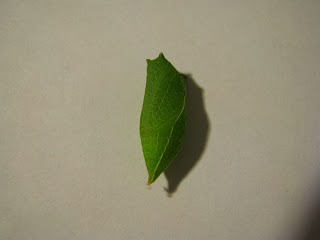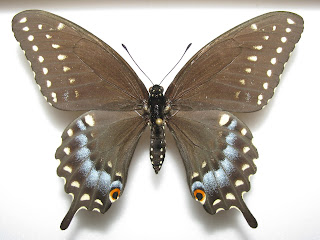Battus philenor (Pipevine Swallowtail) is a really unique looking butterfly in North America, which is hard to mistake for anything else. This butterfly belongs to the genus
Battus (no relation to bats) which is mostly found in Central and South America. In North America north of Mexico, there are only two representatives of this genus, the other being
Battus polydamas (coming soon!). All butterflies in this genus feed on plants in the pipevine family (hence the name), which is scientifically known as the family Aristolochiaceae.
This family of plants contains distasteful toxins, and most other bugs avoid eating pipevine. However, the butterflies in this genus have evolved to take advantage of this plant family. Instead of avoiding it, it eats the plants and then stores the toxins in its own body, and then gains protection from vertebrate predators as a results. The female butterfly also lays eggs which contains these toxins, and so even the eggs get some protection. Additionally, many other butterfly species in North America, which share a similar distribution range, have evolved to look similar to this butterfly, attempting to gain some protection as well.
This butterfly can be found all over the southern half of the USA, with occasional migratory incursions into southern Ontario in Canada. Every once in a while, one will see reports of this butterfly in other parts of Canada, but these are very rare strays, and even in southern Ontario, this butterfly is not expected to be seen in great numbers in most years. There are two subspecies distributed in the USA and Canada. In California, subspecies
hirsuta is present, feeding primarily on
Aristolochia californica. Everywhere else in its range, we find subspecies
Battus philenor philenor. This butterfly can feed on many plants in the pipevine family, depending on what's available in a certain location. Some common host plants
include
A. macrophylla,
A. tomentosa,
A. serpentaria,
A. reticulata. Three additional subspecies are found from Mexico through to Guatamala and Costa Rica (
acauda,
orsua, and
insularis).
Eggs are a rust red and laid in clusters. The young larvae prefer to eat young tender leaves, and the eggs are therefore usually laid on young shoots or tendrils.
These caterpillars are very coordinated, and hatch and eat and moult in near unison. I'm not sure how this happens, and I'm not sure anyone knows yet, but they are all probably synchronized by chemical means. When they first hatch, they are tiny, and you can't see much detail. They are brown with little bumps. At higher magnification, you can see little hairs sticking out from these bumps.
These larvae eat a large amount for their size and also grow quite fast. The egg clusters are usually about 10-20 in size, so that doesn't help either, because if you're going to try to raise this species, you can't just raise one. You pretty much have to raise the whole lot. So if you're going to try this, make sure you have enough pipevine plants around. This above picture shows a cluster of second instar larvae. You can see a bit more detail now, and the caterpillars have slightly larger bumps which are tipped with orange.

Unlike some other swallowtail larvae which show dramatic color changes as they mature, this species does not. As they grow, the bumps and filaments get larger, but the general color scheme stays the same. The larvae are uniformily brown, and have a multitude of filaments and tubercles, with most of the ones in the mid body being tipped with orange. This third instar larva is about to moult. Notice the translucent bump behind the black head capsule. That`s where the new head capsule is developing.
These are fourth instar larvae. Starting at about this stage, they start to disperse a bit. They no longer feed in huge groups, but form smaller congregations or start to feed in solitude. This behavior likely reduces competition for food amongst the larvae.
When fully grown, this caterpillar will be nearly 5 cm in length.
The larva empties its guts and then wanders around for about half a day. After it has settled on a good spot to pupate, it will make a raised silk pad on which to attach its anal prolegs. The picture above shows the caterpillar in the process of building this silk pad, which is that blob of white stuff near its mouth.
After a bit of rest, it will then proceed to construct its silk girdle, which will support it across its mid section when the larva transforms into a pupa. This process takes about 30-45 minutes. Like many other swallowtails which have adapted to survive winters, the pupae of this species may take on two color forms.
The green form is a bright beautiful green, designed to blend in with leaves. Usually, pupae of this color tend to develop into adult butterflies right away, and do not hibernate.
Pupae can also be of the brown form, though to tell you the truth, it`s not really brown. It`s more a purple pastel color. This form usually blends in with twigs and dead leaves, and will usually hibernate (aka diapause) through winter, only to emerge the next spring.
As the butterfly develops within, you will slowly notice that the pupa turns from it`s normal color to black, which is the predominant color of the wings of this species. As it gets closer to emerging from the pupa, you will actually be able to recognize the wing patterns of the future butterfly through the pupal shell. The above picture was taken just as a newly emerging butterfly is pushing its way out of the pupa.
The newly emerged butterfly will find a place where it can hang, so that the wings can expand and straighten with the aid of gravity. The wings take about 10-15 to expand, as the butterfly pumps the veins of the wings with body fluid. It will then take about 2 hours for the wings to become hard enough to sustain flight.




From top to bottom are male (dorsal and ventral) and female (dorsal and ventral) specimens. I kept a few of the butterflies I raised, but let most of them go. I`m not sure how many, if any, survived in the wild. The ones I released as nearly full grown caterpillars were often not relocated when I checked on their food plant later. Either they were really good at hiding (though I`m pretty good at spotting them), or they were eaten. Despite the protection they should gain by the toxins stored in their bodies, the defense isn`t perfect, and the vast vast majority of butterfly larvae die in the wild at the hands of a myriad of predators. Besides, if that were not the case, we`d be overrun with Pipevine Swallowtails.




























































